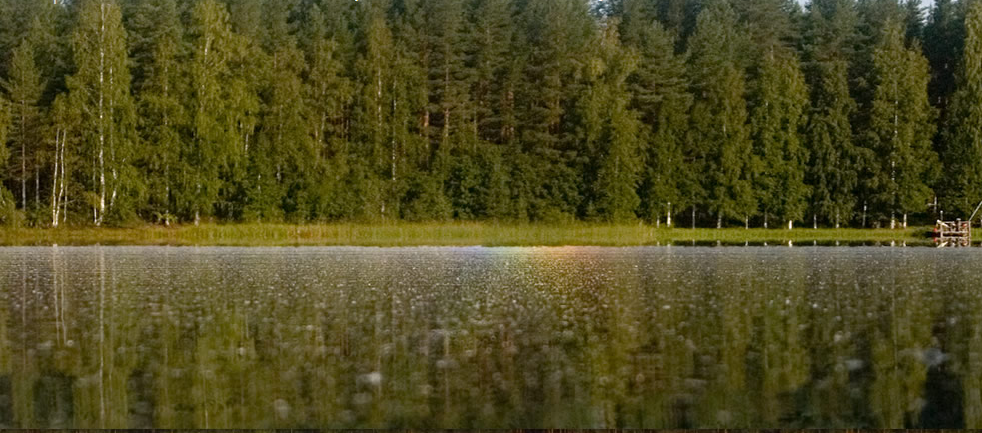Waterborne Dewbow
Exploring the Phenomenon of Waterborne Dewbows
Have you ever seen a dewbow? This captivating atmospheric optics phenomenon occurs when sunlight is refracted and reflected by water droplets, similar to how rainbows are formed. While dewbows are commonly observed on land, such as on lawns or vegetation, they are quite rare over bodies of water. In this article, we will delve into the fascinating world of waterborne dewbows and explore a unique sighting captured by atmospheric optics expert Marko Riikonen.
Dewbows are typically formed when dewdrops hang on leaves and blades of grass, reflecting and refracting sunlight. However, witnessing a dewbow over water presents a captivating and unusual sight. Marko Riikonen, known for his expertise in atmospheric optics, had the opportunity to capture this rare phenomenon from a boat on a lake in Finland.
Upon observing the waterborne dewbow, Marko noticed that the drops were supported on debris floating on the lake's surface. Contrary to what one might expect, there was no algal or oily film present. Instead, only plant and insect litter provided the necessary support for the dewdrops. Marko observed droplets of varying sizes attached to the litter particles, some growing on single particles while others formed on projections of larger particles. Interestingly, most of the particles lacked droplets, making the dewbow visible only near the horizon.
To understand why a dewbow can form over water, it is essential to consider the characteristics of water droplets. Larger dewdrops tend to flatten, which could potentially hinder the formation of a dewbow. However, when the sun is low on the horizon, as was the case in Marko's observation, this flattening does not impede dewbow formation near the lake's horizon. The rays of sunlight that create the rainbow pass through nearly horizontal and circular sections of the droplets. Other parts of the dewbow could not form from such drops.
To capture the waterborne dewbow, Marko held his camera a mere 5 cm above the lake's surface, allowing him to obtain remarkable images that showcase the phenomenon in all its glory. These images offer a unique perspective and highlight the beauty of this atmospheric optics spectacle.
The sighting of the waterborne dewbow was not the only atmospheric phenomenon Marko encountered that day. It was merely a prelude to a day filled with captivating optical phenomena. While the details of these subsequent events are not mentioned in this article, it leaves us intrigued and eager to explore further.
In conclusion, waterborne dewbows are a captivating and rare atmospheric optics phenomenon. Observing a dewbow over a body of water adds an extra layer of intrigue to this already mesmerizing spectacle. Marko Riikonen's sighting in Finland provides valuable insights into the conditions necessary for the formation of a waterborne dewbow and highlights the beauty that can be found in nature's optical displays.


Dewbow over water, Finland Images by Marko Riikonen (site).
�Marko Riikonen.

This was the second rare phenomenon captured by atmospheric optics expert Marko from a boat on a Finland lake early on the morning of August 14 . His first was a reflection glory. Soon after that he witnessed this dewbow formed over the water.
Dewbows on lawns are fairly common. Dewdrops formed during a humid night hang on leaves and blades of grass to reflect and refract sunlight like raindrops. But on water?
In this case the drops were supported on debris on the lake surface. �No algal or oily film was there. Just plant and insect litter. I saw different sized water droplets attached on the litter particles. Some had grown on single particles, others were on the projections of larger particles. The great majority of the particles had no droplets, droplets were rather scarce which is why I think the dewbow was visible only near the horizon.�
Larger dewdrops can also be flattened. But if the sun is low � as here - this does not hinder dewbow formation near to the lake horizon. The rainbow forming rays pass across a nearly horizontal and circular droplet section. Other parts of the dewbow could not form from such drops.
Marko held the camera only 5 cm above the lake to get the two upper rare images.
This was not the end of a day of atmospheric optics. That is the topic of the next OPOD.
Note: this article has been automatically converted from the old site and may not appear as intended. You can find the original article here.
Reference Atmospheric Optics
If you use any of the definitions, information, or data presented on Atmospheric Optics, please copy the link or reference below to properly credit us as the reference source. Thank you!
-
<a href="https://atoptics.co.uk/blog/waterborne-dewbow/">Waterborne Dewbow</a>
-
"Waterborne Dewbow". Atmospheric Optics. Accessed on November 25, 2024. https://atoptics.co.uk/blog/waterborne-dewbow/.
-
"Waterborne Dewbow". Atmospheric Optics, https://atoptics.co.uk/blog/waterborne-dewbow/. Accessed 25 November, 2024
-
Waterborne Dewbow. Atmospheric Optics. Retrieved from https://atoptics.co.uk/blog/waterborne-dewbow/.